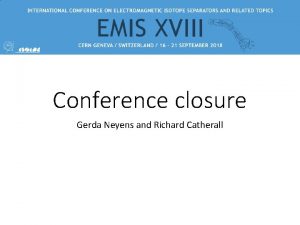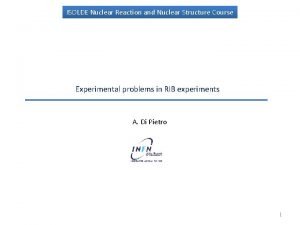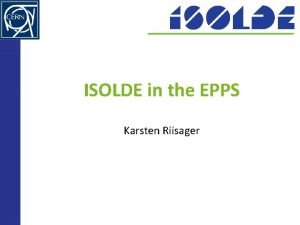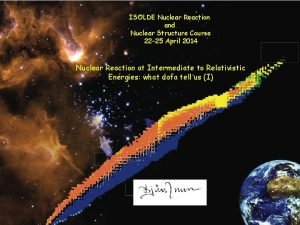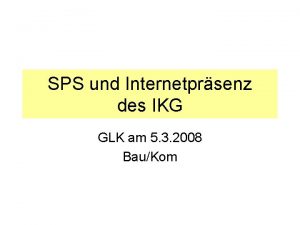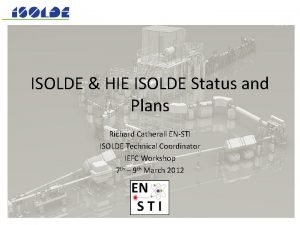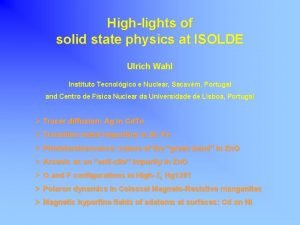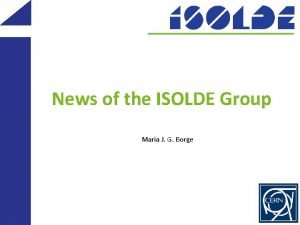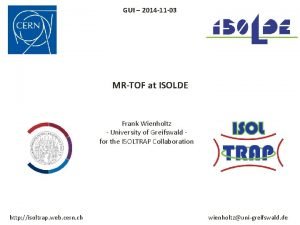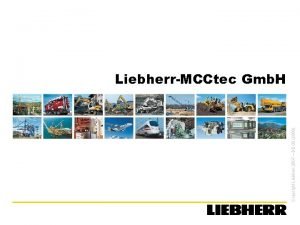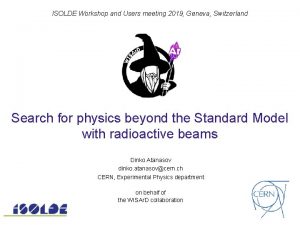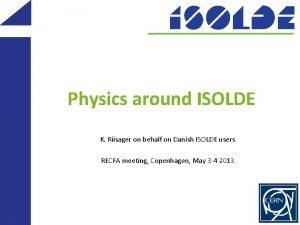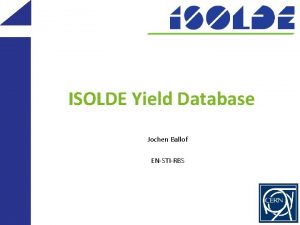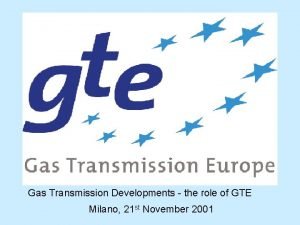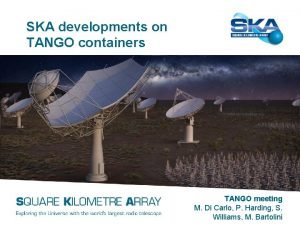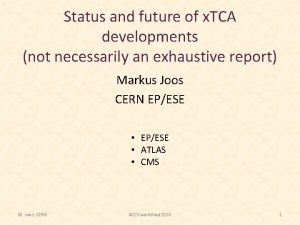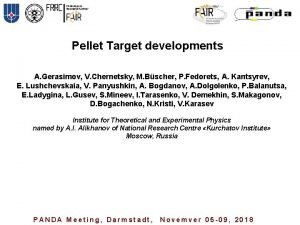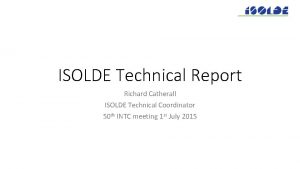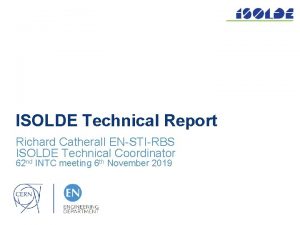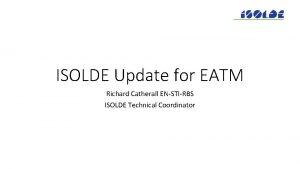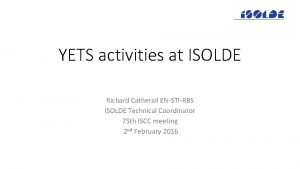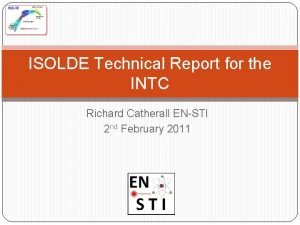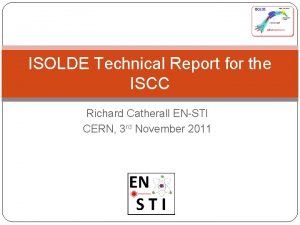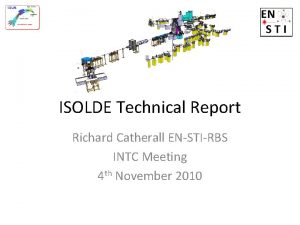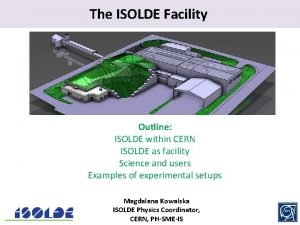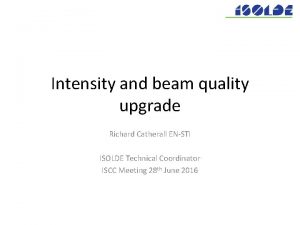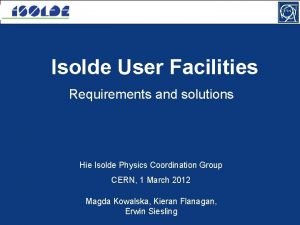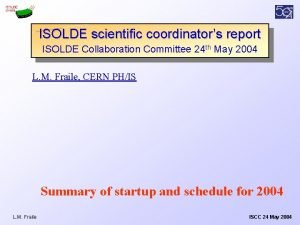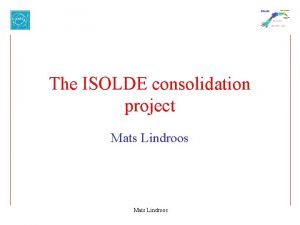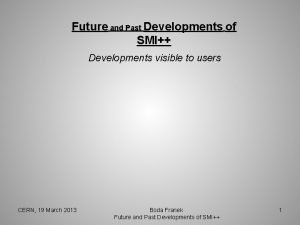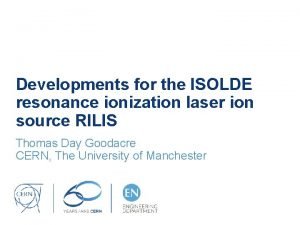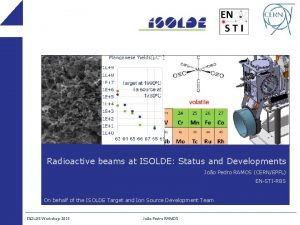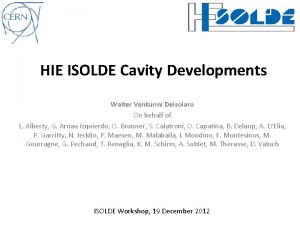Future Developments at ISOLDE Richard Catherall ISOLDE Technical















![The Helicon ion source 1 E+07 1 E+06 Gas feed yield [1/u. C] RF The Helicon ion source 1 E+07 1 E+06 Gas feed yield [1/u. C] RF](https://slidetodoc.com/presentation_image_h/36cf32752832133ca3336c10b16beadf/image-16.jpg)



















- Slides: 35

Future Developments at ISOLDE Richard Catherall ISOLDE Technical Coordinator ISOLDE Workshop and Users Meeting 17 th – 19 th December 2012

Outline • • Introduction …the last few years Target area – – • Robots Hot cell Access New storage Target Development – Recent developments – RILIS – 2 Ge. V @ ISOLDE • Experimental Hall – TSR@HIE-ISOLDE • HIE-ISOLDE Design Study – – – Extraction electrode Target developments Off-line separator RFQ Cooler Charge Breeder upgrade

The last few years… 2005 The Class A Labs 2008 ISCOOL 2009 REX Shielding 2010 & 2011 Front End and HT tube insulator replacement

The Future ISOLDE Facility Robot Upgrade

The Target Handling Robot Upgrade Shielded shelves Exchange point 5

The New ISOLDE Robots

The Target Handling Robot Upgrade: The New Remote Handling System • • • Two industrial 6 axis robots fixed to a suspended 7 th linear axis Radiation resistant – Deported electronics, radiation resistant materials… Complete refurbishment of the system Improved functionalities – Storage, visual inspection More flexibility Large scale mock-up testing before installation 7

Design changes for the new remote handling system • Design change of specific parts – New gripper with redundant functions – Implementation of feedback of each status – Control system includes recovery method – No electronics in the target area – Based on a industrial robot and linear transport system 8

The Future ISOLDE Facility Hot Cell Access Target Storage

Hot Cell: Requirements for waste treatment and packaging 10

Hot cell layout 11

Alpha Gamma Hot Cell: Status • Functional and technical specifications prepared. – In collaboration with the Paul Scherrer Institute. • Invitation to tender September 2012 • Project approved by Finance Committee • Delivery expected January 2014 12

PAD-MAD Access Installation planned for the end of 2013 Robot barrier will be integrated MAD can be removed for Front End passage PAD MMAD CLEFS CHECK POINT RP EDMS no. 1145495

Building 179 extension • New storage – Eliminate the need to transport irradiated targets on the CERN site – Easier handling for access to new hot cell – Compatible with new CERN access system (PAD/MAD) – Compatible with new robots – Buffer zone/dispatch • Medicis laboratory – New off-line separator connected to RABIT system – Preparation laboratory

The Future ISOLDE Facility Target Development RILIS 2 Ge. V p-beam at ISOLDE
![The Helicon ion source 1 E07 1 E06 Gas feed yield 1u C RF The Helicon ion source 1 E+07 1 E+06 Gas feed yield [1/u. C] RF](https://slidetodoc.com/presentation_image_h/36cf32752832133ca3336c10b16beadf/image-16.jpg)
The Helicon ion source 1 E+07 1 E+06 Gas feed yield [1/u. C] RF antenna Pfwd ≤ 250 W f. RF = 0. 01 – 400 MHz 2012 -11 Axial magnetic field for Helicon mode generation 2011 -09 1 E+05 1 E+04 1 E+03 1 E+02 1 E+01 N Plasma chamber Si. O 2, Ø = 12 mm, l = 100 mm Plasma electrode Tungsten, Ø = 0. 9 mm S Two-stage extraction system for improved ion beam quality Uel = 0 – 3 k. V 10 CO 11 CO 15 CO 16 CO Ø Developed by the TISD group for the production of CO+ and CO 2+ , N 2+, and noble gas beams; Ø First online operation 2011/09, upgraded system tested 2012/11; Ø Strong gain achieved on 11 CO; 10 CO and

Laser Ion Source and Trap (LIST) On-Line at ISOLDE LIST device: LIST assembly: Ionization and suppression of contaminants by LIST: RILIS mode ry a n LIST mode i m i l e Pr Ion repeller Laser ionized 30 Mg Suppressed 26 Na, 46 K RF terminals Ø LIST was successfully tested with UCx-target -> No loss of performance over 5 days Ø Suppression of Na-, Al-, K-, Fr-, U-isotopes studied -> Suppression factors varied from 100 to 1000 Ø Laser ionization of radioactive Mg and Po in LIST Fr suppression and laser ionization of Po in LIST First ever LIST on-line physics result: hyperfine structure of 217 Po By Daniel Fink

Static molten salt target for 18 Ne* for b-beams Featured (with 6 He beams) in CERN activity report and EPN (43/5) * And record yields of 11 C as CO+ T. Mendonca (CERN), E. Noah (UNIGE), R. Hodak (Comenius univ), M. Allibert, V. Ghetta (LPSC) TISD team (S. Cimino, S. Marzari), EN-MME, TE-VSC INTC – IS 509 18 Ne ISOL beam @ ISOLDE from static salt target: Concept Salt condensation Yield, D [m 2/s]

New n converter – phase I Tests of simulations with geometry I: Predicted n-rich Zn/Rb improvement of ~ x 20 New converter geometry I : 5 e 3 80 Zn, 5 e 1 80 Rb /m. C 600 81 Zn, ~5 e 2 81 Rb/m. C è Measured improvement ca x 200 ( instead of x 20) Yet some teething problems: clear thermal and mechanical weaknesses Onboard for phase II (2014): Keeping the same Impurity/beam improvement, and increase of yield R. Luis et al, EPJ A 2012 TISD team, S. Marzari, B. Crepieux

ISOLDE RILIS future developments • Extension of RILIS cabin - • Enlarged entrance/storage and work area to maximize the useable laser laboratory space Implement a dedicated, high power Nd: YAG laser for non resonant ionization - • High beam quality industrial laser could significantly improve efficiency for many schemes. Would simplify RILIS setup, increase reliability and reduce setup time. Testing is underway this week On-call operation - Installation of a machine protection and monitoring system to reduce reliance on shift-based operation To be implemented during LS 1 • Investigate RILIS for refractory metals at ISOLDE • Improved RILIS schemes for the Dual RILIS system • • • GENERAL RILIS DEVELOPMENTS Installation of a reference cell at RILIS Pulsed amplification of CW seeded Dye laser or Ti. Sa Improved motorzation of Narrow-band Ti. Sa IONIZATION SCHEMES IN-SOURCE SPECTROSCOPY SELECTIVITY IMPROVEMENTS Further optimization of LIST Improving the laser ion time structure or using a time focus for effective beam gating

Blaze Vs. Edgewave performance comparison Lumera Blaze Edgewave 30 >2 x efficiency improvement for Ga! 25 Blaze laser installed at RILIS on Monday 17 th Dec! • • • 40 W at 10 k. Hz 17 ns Pulse Low Jitter Gaussian beam Much better transmission efficiency to ion source 69 Ga Ion Current, p. A Test of non-resonant ionization step for the gallium scheme Blaze laser test 20 x 2. 2 15 10 5 0 0 10 20 30 Laser Power, W 40 A similar efficiency improvement should be expected for the 17 RILIS elements that use non-resonant ionization for the final step! 50

2 Ge. V proton beam @ ISOLDE • Extension of the 2 Ge. V energy upgrade of the PS-Booster • Letter of Intent submitted to Research Board • Isotopes produced from fission reactions gain x 1. 4 on average • Fragmentation products gain x 2 to x 5 • Spallation products gain of more than x 6 for exotic isotopes.

The Future ISOLDE Facility • TSR @ ISOLDE

TSR@ISOLDE Combine HIE-ISOLDE beams with Heidelberg heavy-ion Test Storage Ring TSR and HIE-ISOLDE, a nice couple with: broad range of elements and isotopes wide energy range e-cooled beams cw beams in-ring and external experiments First storage ring with ISOL-facility! TSR at MPI-K Heidelberg Circumference: 55. 42 m Vacuum: ~few 1 E-11 mbar Acceptance: 100 mm mrad Multiturn injection: m. A current Electron cooler: transverse Tcool in order of 1 s RF acceleration and deceleration possible

HIE/REX and TSR compatible 1. REX/HIE and TSR well adapted energy wise A/q = 2. 5 W = 16. 8 Me. V/u βγ = 0. 187 HIE stage 2 b Many different ways of operating the TSR A/q = 4. 5 W = 10. 2 Me. V/u βγ = 0. 147 2. Need to hold the ions for up to 2 s in REX low energy stage => REXTRAP essential Ion 7 Be 18 F 70 Ni 132 Sn 182 Pb Z 4 9 30 50 50 82 82 q 3 9 25 30 39 53 64 A/q 2. 33 2 2. 33 4. 4 3. 38 3. 43 2. 84 Breeding time (ms) 20 100 350 120 700 * 1000 * EBIS upgrade needed * to be tested 3. REXEBIS capable of producing sufficiently low A/q for almost all elements (< 10 Me. V/u)

Possible TSR installation * Injection beam-line calculated * Study of building performed extraction line TSR ISOLDE Proposed layout to fit the TSR: * Installation above the CERN service-tunnel * Tilted beam-line coming up from the machine. HIE-Linac HIE-HEBT

Next steps 1. TSR at ISOLDE technical design report M. Grieser et al. , EPJ Special Topics May 2012, vol 207, Issue 1, pp 1 -117 2. Approved by CERN Research board, May 2012 “The installation of TSR, as an experiment to be included in the HIE-ISOLDE programme, was approved by the Research Board. The timescale will be defined once the study of its integration has been completed. ” 3. Integration study on-going Report to CERN management Q 3 2013 Within HIE-ISOLDE project Charge breeder upgrade study to: A. Cover all TSR physics cases Bare nuclei up to Z~60 Li-like to U B. Go to >10 Me. V/u beam energy

The HIE-ISOLDE Design Study Baseline parameters due to Linac 4 and PSB upgrade 1 x 1014 protons per bunch (3 x 1013) 900 ms Booster supercycle? (1200 ms) 2 Ge. V beam energy? (1. 4 Ge. V) ~ 14 k. W of primary beam (2. 8 k. W)

Redesign of Extraction System Fixed electrodes, larger apertures, simpler and more compact frame See poster by Jacobo Montano Carrizales

Thermal Studies • Re-design of target – Indirect heating of target container – Uniform heat distribution across the target container – Heat pipes for cooling

Off-line 2 Mass Separator Layout A test bench for validation • • FE FE + RFQ + 90° magnet FE + WF + RFQ + 90° magnet

RFQ Cooler • Approach – – Alignment • Adjustable alignment of the electrodes Pressure gradient • Reduce pressure at injection and extraction electrodes by adding more holes to the plates • • • RFQ Cooler will be part of the test stand Drawings done and procurement started RFQ Cooler design report done • CST Particle Studio used: – – To simulate particle trajectories To provide acceptances on parts of the machine To diagnose electrical charge build up Shapes, voltages and distances can be simulated Carla Babcock

Design layout for breeder upgrade Important changes compared to REXEBIS: Electron energy increase (x 30) : HV design Electron current increase (x 10 -20): HEC 2 electron gun Current density increase (x 50 -100) : high compression Brillouin type gun, magnetic field increase ( 2→ 6 T) Current increase (x 10 -20) + HV: high power dissipation at the collector Current increase + XHV: distributed differential pumping system

Summary • An impressive transformation of the ISOLDE Facility is planned for the coming years – Target area – Medicis – HIE-ISOLDE – TSR@ISOLDE – Target development • There will be an inevitable impact on operations – Resources – RIBs > from target to TSR – Safety, Access…

Thank you for your attention • Acknowledgements – – – – T. Stora B. Marsh K. Flanagan S. Marzari F. Wenander J-L Grenard A. Shornikov J. Montano C. Babcock S. Cimmino T. Giles V. Barozier M. Kronberger A. Stadler …and the ISOLDE Collaboration
 Richard catherall
Richard catherall Richard catherall
Richard catherall Paul catherall facts
Paul catherall facts Future perfect or future continuous
Future perfect or future continuous Future perfect future continuous future perfect continuous
Future perfect future continuous future perfect continuous Richard iii pursuit of power
Richard iii pursuit of power Reaction structure
Reaction structure Karsten riisager
Karsten riisager Phys. rev. c
Phys. rev. c Sps ikg
Sps ikg Isolde
Isolde Isolde reveal
Isolde reveal Isolde maria johan
Isolde maria johan Isolde frank
Isolde frank Offshorekrane / bohrinselkrane
Offshorekrane / bohrinselkrane Isolde workshop
Isolde workshop Isolde k
Isolde k Isolde yield database
Isolde yield database Patterns of development comparison and contrast
Patterns of development comparison and contrast Democratic developments in england
Democratic developments in england Political developments in the early republic
Political developments in the early republic Donmeg developments
Donmeg developments Transmission developments
Transmission developments Recent developments in object detection
Recent developments in object detection Ska developments
Ska developments Huron creek
Huron creek How did parliament emerged victorious in medieval england
How did parliament emerged victorious in medieval england Pattern development engineering
Pattern development engineering In the colonial era developments such as the new england
In the colonial era developments such as the new england Cultural development of sahelanthropus tchadensis brainly
Cultural development of sahelanthropus tchadensis brainly Name of prism
Name of prism Political developments in the early republic
Political developments in the early republic Comtel atca
Comtel atca Target developments
Target developments Chartered developments
Chartered developments Medical developments international penthrox
Medical developments international penthrox
